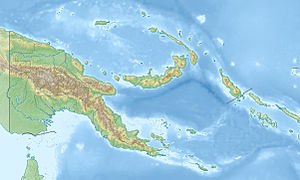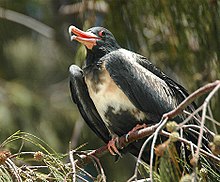Saibai
| Saibai Island | ||
|---|---|---|
| Landsat image by Saibai | ||
| Waters | Pacific Ocean | |
| Geographical location | 9 ° 24 ' S , 142 ° 41' E | |
|
|
||
| length | 21.8 km | |
| width | 5.2 km | |
| surface | 107.9 km² | |
| Highest elevation | 2 m | |
| Residents | 337 (2006) 3.1 inhabitants / km² |
|
| main place | Saibai | |
|
Torres Strait Islands location : Saibai above, right. |
||
Along with Boigu and Dauan, Saibai Island is part of the northwest group of the Torres Strait Islands in the strait between Australia and Papua New Guinea . Saibai is the third largest Torres Strait Island, after Prince of Wales Island and Moa Island . Administratively, the approximately 5 x 22 km island is one of the Top Western Islands , an island region in the Torres Shire administrative district of Queensland, Australia .
geography
The flat mangrove island, located just 4 km from the south coast of the western province of Papua New Guinea, has its highest elevation of around 1.7 m, and is therefore always at risk of flooding when the waves are strong. The 350 inhabitants only settle on the coast. Sometimes they do not live continuously on the island. 75% of them belong to the Torres Strait Islanders , 25% are Papuan . There is also a small minority of European descent.
The main town of Saibai with 171 inhabitants is located in the north-west of the island. Three kilometers away at the western end of the island is the village of Churum with 128 inhabitants.
Immediately north of Saibai is the neighboring island of Kauamag . It is separated from Saibai by an arm of the sea seven kilometers long and 180 to 650 meters wide, which is almost closed at its eastern end. Two other very small, nameless islands lie off the north coast.
Residents
The predominant language is Kalaw Kawaw Ya , the former lingua franca of the microregion.
In 1871 the islanders were converted to Christianity by the London Missionary Society . The missionaries removed the sacred Adhibuya stone of the Aith tribe. According to the old belief, the stone protected the islanders from the warring seafaring tribe of the Kiwai (also Kupamal ).
During the First World War , a cargo cult became very fashionable, the Zaman Wislin , from German Wesleyan ( German Wesleyisch ). That soon happened again, but this cult can still be found occasionally.
history
After Saibai was hit by a tidal wave again in the early 20th century , some of the islanders finally accepted the government's offer and settled on the Cape York Peninsula on mainland Australia. Under the leadership of Bamaga Ginau , they founded the communities of Bamaga and Seisia, which still exist today .
economy
When Papua New Guinea gained independence from Australia in 1975, the islanders insisted on staying with Australia. However, they did not renounce to maintain traditional trade and family relationships with the mainland. A system of special permits, coupled with strict quarantine regulations, allows small border traffic .
Traditionally there are trade relations with the mainland of New Guinea , despite hostilities with the Kiwai from the mouth of the Fly and the Thugeral (in German warriors ) from the Morehead River on the border between Papua New Guinea and the Indonesian West New Guinea .



